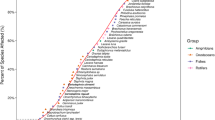Abstract
Grass shrimp (Palaemonetes pugio) were exposed to either waterborne or sediment-source concentrations of fenvalerate, cypermethrin, 1,2,4-trichlorobenzene (TCB), tributyltin oxide (TBTO), triphenyltin oxide, and di-n-butylphthalate in static or flow-through test systems. Similarly, amphioxus (Branchiostoma caribaeum) were tested with fenvalerate, TCB, and TBTO. The LC50 and no-effect and 100% mortality concentrations are reported from 96-hr and 10-day tests. The toxicity of contaminated sediments could be explained by chemical partitioning into overlying or interstitial water. Amphioxus is not recommended as a routine test species because of (1) difficulty in distinguishing severely affected from dead individuals, (2) inability to determine the status of burrowed animals without disrupting sediment, (3) their relative lack of sensitivity in acute exposures to toxic chemicals, and (4) difficulty in routine collection of sufficient numbers of animals. Grass shrimp, however, are useful as an epibenthic test species for waterborne and sediment-source toxicants.
Similar content being viewed by others
References
Adams WJ, Kimerle RA, Mosher RG (1985) Aquatic safety assessments of chemicals sorbed to sediments. In: Cardwell RD, Purdy R, and Bahner RC (eds) Aquatic Toxicology and Hazard Assessment: Seventh Symposium, ASTM STP 854; ASTM, Philadelphia, PA pp 429–453
(APHA)American Public Health Association, American Water Works Association, Water Pollution Control Federation (1985) Standard Methods for the Examination of Water and Wastewater, 16th ed, Washington, DC
Anderson G (1985) Species Profiles: Life Histories and Environmental Requirements of Coastal Fishes and Invertebrates (Gulf of Mexico): Grass Shrimp. Biological Report 82 (11.35). US Dept Interior, Fish and Wildlife Service, Washington, DC
Boschung HV, Gunter G (1962) Distribution and variation ofBranchiostoma caribaeum in Mississippi Sound. Tulane Studies Zoology 9:245–257
Cardwell RD, Sheldon AW (1986) A risk assessment concerning the fate and effects of tributyltins in the aquatic environment. In: Oceans 86 Conference Record, 1986 Sept 23–25, Washington, DC, Marine Technology Society, pp 1117–1129
Clark JR, Patrick JM, Jr, Middaugh DP, Moore JC (1985) Relative sensitivity of six estuarine fishes to carbophenothion, chlorpyrifos, and fenvalerate. Ecotoxicol Environ Safety 10:382–390
Finney, DJ (1971) Probit Analysis, 3rd ed. Cambridge Univ Press, Cambridge, Great Britain
Hill IR (1985) Effects on non-target organisms in terrestrial and aquatic environments. In: Leahey JP (ed) The Pyrethroid Insecticides, Taylor and Francis Ltd, London, pp 151–262
Kendall MG, Stuart A (1973) The Advanced Theory of Statistics, 3rd ed, Vol. 3. Hafner Publishing Co, New York, pp 342–430
Laughlin RB, Guard HE, Coleman WM III (1986) Tributyltin in seawater: speciation and octanol-water partition coefficient. Environ Sci Technol 20:201–204
Linden E, Bengtsson B-E, Svanberg O, Sundstrom G (1979) The acute toxicity of 78 chemicals and pesticide formulations against two brackish water organisms, the bleak (Alburnus alburnus) and the harpacticoidNitocra spinipes. Chemosphere 8:843–851
Mayer FL, Ellersieck MR (1986) Manual of acute toxicity: Interpretation and data base for 410 chemicals and 66 species of freshwater animals, US Fish and Wildlife Service, Resource Publication 160, Washington, DC
McKenney CL, Hamaker DB (1984) Effects of fenvalerate on larval development ofPalaemonetes pugio (Holthuis) and on larval metabolism during osmotic stress. Aquat Toxicol 5:343–355
McLeese DW, Metcalfe CD (1980) Toxicities of eight organochlorine compounds in sediment and seawater toCrangon septemspinosa. Bull Environ Contam Toxicol 25:921–928
Muir DCG, Rawn GP, Townsend BE, Lockhart WL, Greenhalgh R (1985) Bioconcentration of cypermethrin, deltamethrin, fenvalerate and permethrin byChironomus tetans larvae in sediment and water. Environ Toxicol Chem 4:51–61
Nelson GE (1969) Amphioxus in Old Tampa Bay. Q J FL Acad Sci 31:93–100
Phelps HL, Hardy JT, Pearson WH, Apts CW (1983) Clam burrowing behavior: Inhibition by copper enriched sediment. Mar Pollut Bull 14:452–455
Phelps HL, Pearson WH, Hardy JT (1985) Clam burrowing behavior and mortality related to sediment copper. Mar Pollut Bull 16:309–313
Pierce EL (1965) The distribution of lancelets (Amphioxi) along the coasts of Florida. Bull Mar Sci 15:480–494
Schimmel SC, Garnas RL, Patrick JM, Jr, Moore JC (1983) Acute toxicity, bioconcentration, and persistence of AC222,705, benthiocarb, chlorpyrifos, fenvalerate, methyl parathion, and permethrin in the estuarine environment. J Agric Food Chem 31:104–113
Swartz RC, Deben WA, Sercu KA, Lamberson JO (1982) Sediment toxicity and the distribution of amphipods in Commencement Bay, Washington, USA. Mar Pollut Bull 13:359–364
Tooby HE, Hursey PA, Alabaster JS (1975) The acute toxicity of 102 pesticides and miscellaneous substances to fish. Chem Ind 12:523–526
U.S. Environmental Protection Agency (1978) Bioassay Procedures for the Ocean Disposal Permit Program. EPA-600/9-78-010, USEPA Environmental Research Laboratory, Gulf Breeze, FL
— (1979) Water Related Environmental Fate of 129 Priority Pollutants. Vol. II. EPA-440/4-79-029b, USEPA, Cincinnati, OH
— (1980a) Ambient Water Quality Criteria for Chlorinated Benzenes. EPA-440/5-80-028, USEPA, Cincinnati, OH
— (1980b) Ambient Water Quality Criteria for Phthalate Esters. EPA-440/5-80-067, USEPA, Cincinnati, OH
Welsh BL, (1975) The role of grass shrimp,Palaemonetes pugio, in a tidal marsh ecosystem. Ecology 56:513–530
Wong PTS, Chan YK, Kramar O, Bengert GA (1982) Structuretoxicity relationship of tin compounds on algae. Can J Fish Aquat Sci 39:483–488
Worthing CR (1979) The Pesticide Manual, A World Compendium, 6th ed. British Crop Protection Council, Croydon, England
Author information
Authors and Affiliations
Rights and permissions
About this article
Cite this article
Clark, J.R., Patrick, J.M., Moore, J.C. et al. Waterborne and sediment-source toxicities of six organic chemicals to grass shrimp (Palaemonetes pugio) and amphioxus (Branchiostoma caribaeum). Arch. Environ. Contam. Toxicol. 16, 401–407 (1987). https://doi.org/10.1007/BF01055260
Received:
Revised:
Issue Date:
DOI: https://doi.org/10.1007/BF01055260




